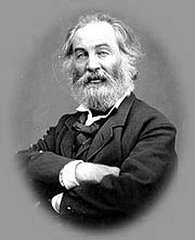 Big Frank has been reading Frost again. We all know his great poem “The Road Not Taken”. The general reading of this poem takes the last aphoristic couplet as the gist of the poem “I took the one less traveled by / And that has made all the difference.” Perhaps most readers also like to think of themselves in the same light – as kind of mavericks, striking out on their own. However, Frost, as is often the case actually presents a more complex, and ironic reading. In fact, both roads were equally untraveled. If you look at the beginning of the third stanza it reads: “And both that morning equally lay/ In leaves no steps had trodden black.” In fact there may well be no such thing as a road untraveled. Nonetheless, we, like the narrator of this poem, often like to think – perhaps it serves some kind of consolation – that we struck out on some path nobody else ever took. This ironic reading opens a much richer vein of truth in this poem.
Big Frank has been reading Frost again. We all know his great poem “The Road Not Taken”. The general reading of this poem takes the last aphoristic couplet as the gist of the poem “I took the one less traveled by / And that has made all the difference.” Perhaps most readers also like to think of themselves in the same light – as kind of mavericks, striking out on their own. However, Frost, as is often the case actually presents a more complex, and ironic reading. In fact, both roads were equally untraveled. If you look at the beginning of the third stanza it reads: “And both that morning equally lay/ In leaves no steps had trodden black.” In fact there may well be no such thing as a road untraveled. Nonetheless, we, like the narrator of this poem, often like to think – perhaps it serves some kind of consolation – that we struck out on some path nobody else ever took. This ironic reading opens a much richer vein of truth in this poem.The Road Not Taken
By Robert Frost
Two roads diverged in a yellow wood,
And sorry I could not travel both
And be one traveler, long I stood
And looked down one as far as I could
To where it bent in the undergrowth.
Then took the other, as just as fair,
And having perhaps the better claim,
Because it was grassy and wanted wear;
Tough as for that, the passing there
Had worn them really about the same,
And both that morning equally lay
In leaves no step had trodden black.
Oh, I kept the first for another day?
Yet knowing how way leads on to way,
I doubted if I should ever come back.
I shall be telling this with a sigh
Somewhere ages and ages hence;
Two roads diverged in a wood, and I –
I took the one less traveled by,
And that has made all the difference.
















